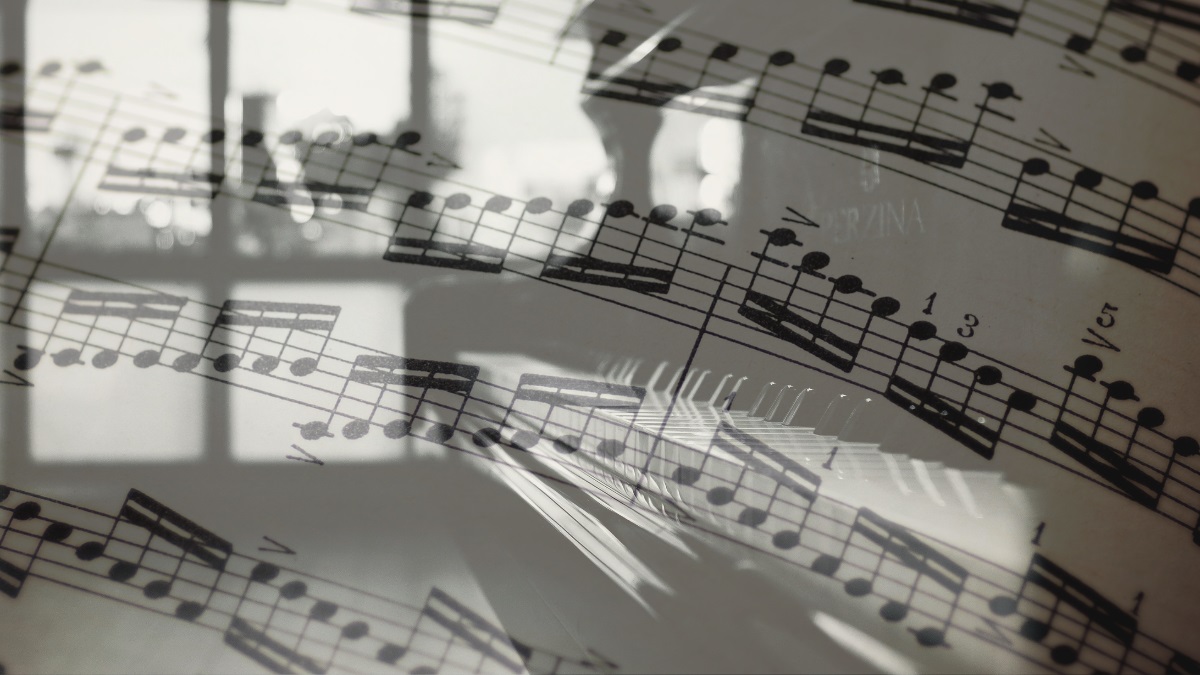If you’ve ever learned to play a musical instrument at school, then your teacher probably gave you scales to practice.
Although the beauty of music lies in the way it tackles our different emotions with surprising notes, some patterns can prepare us subconsciously for the notes that follow. So, what is a scale in music, and what are the different types?
In short, a scale refers to a set of notes and how they’re ordered according to pitch or fundamental frequency. There are different types of major and minor scales, and some of them are more common than others. Keep on reading to learn more about them.
What is a Scale in Music?
When musicians play music, they play according to scale or a pattern that puts the notes in a logical order. So, a scale refers to this pattern, which can be an increasing or decreasing scale based on the pitch and whether it’s ascending or descending.
Generally, a scale spans a single octave, and higher and lower octaves will simply repeat the scale in different notes. This octave-repeating pattern usually sets the notes from low pitches to higher pitches.
Each scale is divided into different steps, and a scale step refers to the distance or interval between two successive steps on the same scale. Scale steps aren’t equal because there’s no limit to how many notes can be included in the same music interval.
A scale that shows the repetition of an octave can be represented in a circular form where the pitches are arranged.
This arrangement depends on whether the pitches are increasing, where there is a bracket that shows whether the last note is in a higher or lower octave than the first one.
The notes in a music scale are numbered from the first one. Two notes can also create an interval in relation to each other.
Why Should You Learn Scales?
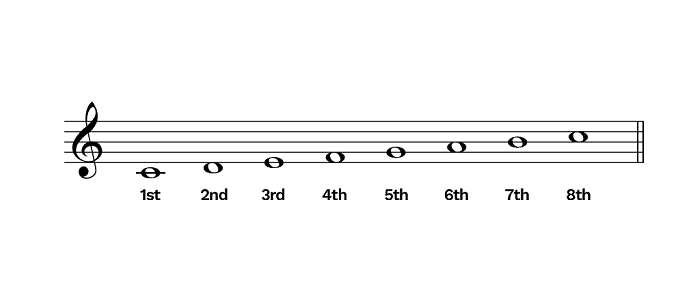
Scales are fundamental in music history. They set the tone for the music piece or song, and this is why creating a cover might involve playing the song in a different scale.
If you’re a music student or simply a music enthusiast, learning about scales will give you the needed knowledge about the foundation of music. Scales represent the framework that combines other elements to create a coherent piece of music that can evoke emotions.
This is why scales provide you with different ideas for improvising or building notes for leads, basslines, hooks, or melodies.
Moreover, when a musician is playing a piece with other musicians, a scale will keep them in key, so they can play in harmony with the other instruments.
What Are the Different Types of Scales?
There are two ways to differentiate between music scales. The first one is based on the nature of the scale, and the second one is based on the number of pitch classes they contain.
There are two main types of music scales; major and minor. In total, the number of music scales is 48. 12 of which are major music scales. The rest are minor scales that are further divided into natural, melodic, and harmonic.
These music scales are divided based on their structure and the relationship between notes, eventually affecting how the scale is built.
When music scales are divided based on the number of pitch classes each one of them contains, we have seven different scales; chromatic, nonatonic, octatonic, heptatonic, hexatonic, pentatonic, and tetratonic.
Major Scales

The major scales are the most widely used scales in music composition. They’re diatonic scales with seven different notes, and each one of them is arranged in order to follow a specific pattern, making the scale easy to recognize.
The most popular scale is the C major, and it’s also the easiest because it doesn’t require sharps or flats. In major scales, every note is referred to as a scale degree, and each one of them is given a name based on its function.
- Tonic: This is the first degree in the scale and the tonal center as the chord moves from dissonance to consonance. In most music pieces, music composers choose to start their composition and end it with the tonic note. In the solfège system, it’s sung as do.
- Supertonic: This is the second degree in the diatonic scale, and in the solfège system, it’s sung as re. A supertonic chord is a predominant chord, which normally resolves to a dominant chord.
- Mediant: This represents the third note or degree in the scale and is located halfway between the tonic and dominant steps. In the solfège system, it’s sung are mi. It can be a major or a minor third.
- Subdominant: This is the fourth degree in the scale and is located at the same distance below the tonic as the dominant note is above the tonic. In the solfège system, it’s sung as fa.
- Dominant: This is the fifth note in the scale and the second most important one after the tonic. In the solfège system, it’s sung as sol. A triad built on this note is called a dominant chord, and it creates instability that a tonic has to stabilize for proper resolution.
- Submediant: This is the sixth note in the scale and is also called the lower mediant because it’s halfway between the tonic and the subdominant steps. It’s sometimes called the super dominant, and in the solfège system, it sounds like la in a major or fa in a minor.
- Leading Tone: This is the seventh note or step in the scale and leads to a note that is either one semitone higher or lower on the scale.
In the solfège system, it’s sung as ti and is used to build a leading tone triad, which s usually used as a passing chord that connects the notes of two diatonic chords.
In the end, there’s another tonic that serves as the first note in the following octave if the octaves are to continue. In some cases, the degrees in the scale are also numbered to show their position instead of the previous names that show their functions.
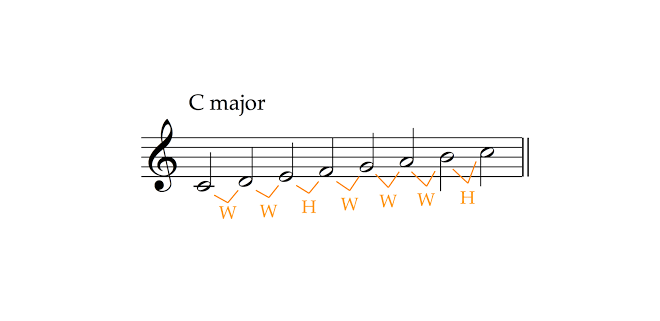
These notes follow each other to set up the other harmonies within the musical composition. In a major scale, the pattern that makes up the scale is made of whole and half steps.
The order is whole, whole, half, whole, whole, whole, and half. This order is used regardless of the starting pitch.
Major scales are extremely popular in Western music and were widely used through the mid to late baroque period till the classical and romantic period.
The major scale has other names in different cultures. For example, it’s called Sankarabharanam in Carnatic music and Bilaval in Hindustani classical music.
When the music is composed in a major key, the notes in the corresponding major scale are considered diatonic notes, while the others are considered chromatic notes. Thus, chromatic intervals are made of two chromatic notes or diatonic and chromatic notes.
Minor Scales
Minor scales are subdivided into natural, chromatic, or melodic. Each pattern is based on how the scale starts. Minor scales can also be divided based on the number of pitches.
Natural Minor Scale

The natural minor scale is a diatonic scale that is built starting from the sixth note or step of its relative major scale. Thus, every major key has a relative minor which corresponds to the sixth scale step.
A natural minor scale can also be built by altering a major scale with accidentals. In this case, each degree will be represented with a number. Without a flat, the number represents a major interval, while the number with a flat represents a minor interval in the following pattern:
1, 2, ♭3, 4, 5, ♭6, ♭7, 8
For example, a C natural minor scale can be built by lowering the third, sixth, and seventh degrees of steps of the C major scale by one semitone. As a result, the key of C minor is called the parallel minor of C major.
In these scales, the pattern of whole and half steps make the scale easy to recognize. The interval pattern follows the following sequence; whole, half, whole, whole, half, whole, and whole.
Harmonic Minor Scale
The notes of the harmonic minor scale are the same as the natural minor scale of the same key, except that the seventh degree or step is raised by one semitone.
As a result, this raise will create an augment second or an interval that spans three semitones between the sixth and seventh steps of the scale.
As a result, the harmonic minor scale is represented in the following pattern:
1, 2, ♭3, 4, 5, ♭6, 7, 8
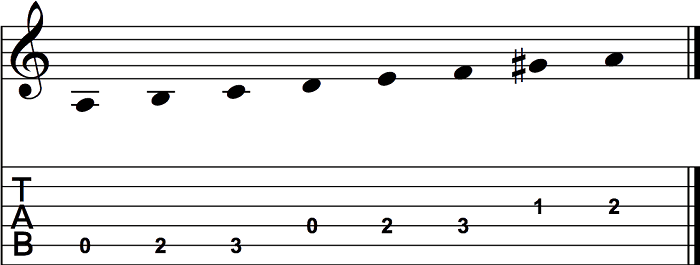
A harmonic minor scale is built by lowering the third and sixth degrees of the parallel major scale by one semitone.
In this scale, the seventh degree is the leading tone to the tonic because it’s only a semitone lower than the tonic, where it’s a whole note lower in a natural minor scale.
It’s called the harmonic minor scale because it’s the foundation of harmonies in minor keys. In this scale, there are two chords that are created by one interval; an augmented triad which is generated by major thirds, and a diminished seventh chord which is generated by minor thirds.
The harmonic minor scale is used melodically, usually descending more often than ascendingly. Popular examples include the first movement of Schubert’s Death and the Maiden Quartet and the finale of Beethoven’s String Quartet No. 14.
The intervals of a harmonic minor scale follow the following pattern; whole, half, whole, whole, half, augmented second, and half.
The upper tetrachord of this scale corresponds to the Hijaz jins or maqam, which is widely used in Middle Eastern music. In this case, it’s referred to as the Mohammedan scale or Nahawand.
A little adjustment to the harmonic scale by raising the fourth degree creates the Hungarian minor scale, which is also known as the Gypsy Run or the Egyptian Minor Scale.
This scale is widely used in heavy metal subgenres and several popular songs like Bobby Brown’s My Prerogative.
Melodic Minor Scale

The melodic minor scale is an adjustment to the harmonic minor scale to create a smoother transition than that created by the augmented second between the sixth and seventh degrees.
In a harmonic scale, this interval can create an awkward leap, especially in vocal music. For this reason, composers opted for using a whole step instead of half steps between these degrees for smooth melody writing and transition.
As a result, the sixth degree is either raised by a semitone or lowered by a semitone to create the melodic minor scale.
Raising the sixth degree is the technique used when a melodic minor scale is created in an ascending form. However, when the scale is descending, composers usually lower the seventh degree instead.
The first form of the melodic minor scale is known as the ascending minor scale or jazz minor scale. It’s noted as follows:
1, 2, ♭3, 4, 5, 6, 7, 8.
The descending one is identical to the natural minor scale, and it’s noted as follows.
1, 2, ♭3, 4, 5, ♭6, ♭7, 8
Composers usually choose one form or the other, depending on whether one of the two notes is part of the most recent chord played. A melodic minor scale is used in several popular rock and pop songs like Sorry Seems To Be The Hardest Word by Elton John and Yesterday by The Beatles.
Chromatic Minor Scale
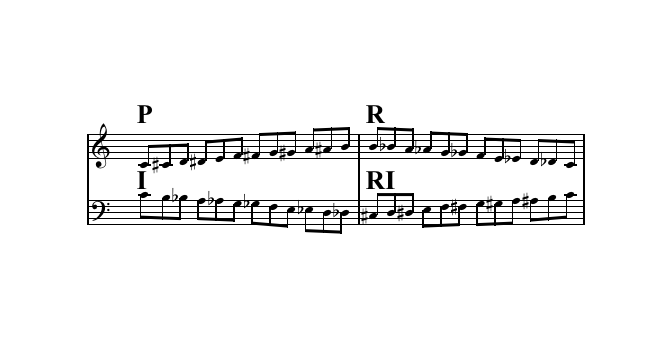
The chromatic minor scale is made of twelve pitches or pitch classes, and the notes are separated by intervals of a semitone. This scale is also called the dodecatonic scale and is produced by most of the Western musical instruments, like the piano.
Other instruments like the violin are able to produce notes between those notes that are available on the piano. These notes are called micronotes.
Despite being a fundamental component of Western music, the chromatic minor scale is rarely used entirely in musical compositions.
Each tone is known as a half-step tone, and the scale covers all of the twelve available pitches, so there’s only one chromatic scale. This scale is made of all the white and black keys in one octave of the piano, and they’re all the same distance apart from each other.
In general, the chromatic scale is notated with sharp signs when it’s ascending and flat signs when it’s descending. Historically, the Pythagorean chromatic scale represented the most common conception of the modern one.
In this old scale, the twelve semitones have two different sizes, so it’s not perfectly symmetric, and it requires tuning.
The chromatic scale gets its name from the Greek word chroma, which refers to the scale’s ability to add color or embellishments to the tones of the major and minor scales. It gives the sense of motion and tension, usually used to evoke emotions of sadness and loss.
As music compositions evolve, the chromatic scale is being used more independently of the major and minor scales, sometimes used as a basis for entire compositions.
Nonatonic Scale
The nonatonic scale is a nine-note scale with a chromatic variation of a major scale with a flat third and seventh degree. This scale is widely used in blues music, with these notes known as the blues notes.
This scale is also played using quarter tones added to the third and seventh steps of the minor blues scale. It’s usually used by jazz and blues musicians for improvising melodies.
Octatonic Scale
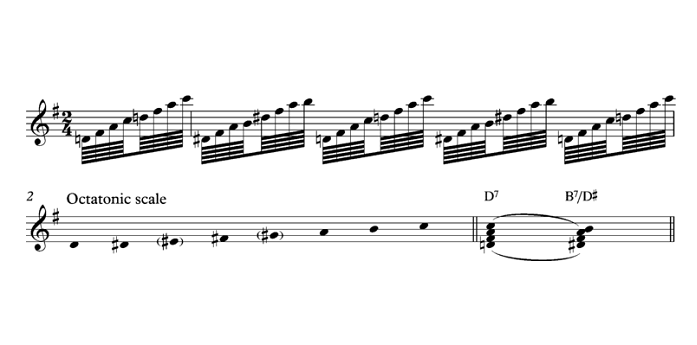
This is an eight-note musical scale that became popular in the early 20th century. During this period, it was widely used by Russian composers, so it was called the Korsakovian scale. It’s also associated with the Dutch composer Willem Pijeper, so it’s called the Pijper scale.
In the jazz theory, this scale is called the diminished scale because it features the interlocking of two diminished seventh chords.
An octatonic scale either begins its ascent with a whole step or with a half step. These two modes are referred to as the whole step/half step diminished scale or the half step/whole step diminished scale.
This scale dates back to the 7th-century Persian music, where it was called the Zar ef Kend or string of pearls, where the two different sizes of intervals are like two different sizes of pearls.
In the 19th century, Beethoven used this scale in the chord progression of his Piano Sonata No. 11 in B♭, Op. 22.
However, the beginning of the 20th century marks the widespread usage of this scale by Russian musicians in pieces like The Rite of Spring and the Symphonies of Wind Instruments by Stravinsky.
Other musicians who used this scale include Alberto Ginastera, George Crumb, and John Williams.
Heptatonic Scale
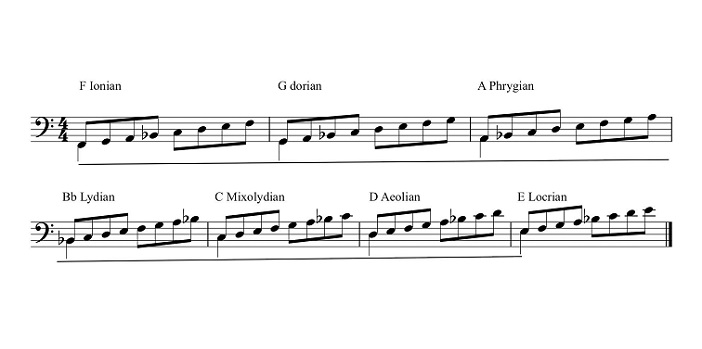
A heptatonic scale is the most widely used scale in Western music and can either be a major or minor scale. In Western music, when a heptatonic scale uses only whole notes and half notes, it’s known as a diatonic scale. There are seven modes of this scale.
- Ionian mode is the major scale.
- Dorian mode is one of the medieval musical modes and is known as the Russian minor in modern music.
- Phrygian mode is related to the natural minor scale, but the second scale step is lowered by a semitone.
- Lydian mode is a rising pattern made of three whole tones, a semitone, two whole tones, and a final semitone.
- Mixolydian mode was commonly used in medieval church music. It’s currently known as the fifth mode of the major scale.
- Aeolian mode or the natural minor scale and the sixth mode of the major scale. It’s used in several popular songs like Pink Floyd’s Shine On You Crazy Diamondand Phil Collins In the Air Tonight.
- Locrian mode is a scale that starts from a B and only uses the white keys from there when played on the piano. In its ascending form, it’s made of a key note, half step, two whole steps, another half step, and three final whole steps.
Modes in scales like the colors of the spectrum as they range from light to dark. The scales with the highest and most raised notes are the brightest.
The Lydian mode is a great example of these scales. A mode with lower notes like a Phrygian is the darkest.
This is why using modes is a great way of manipulating a musical creation, as the composer can achieve brighter or more agonizing tones that aren’t found in major and minor scales.
Pentatonic Scale
This scale has five notes per octave and is one of the oldest scales developed by several ancient civilizations. There are two types of pentatonic scales; the ones that contain semitones and the ones that don’t.
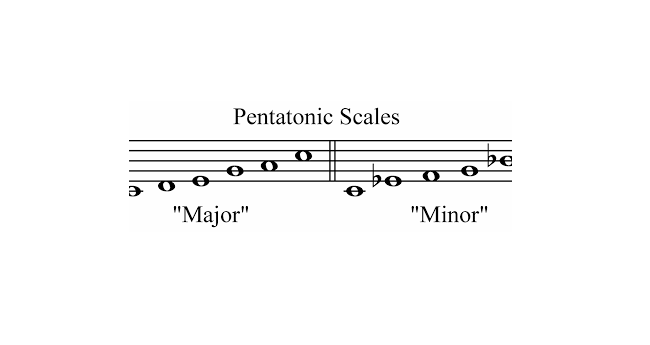
A pentatonic scale can be a major or minor scale. It’s widely used in several traditional music genres like Sudanese music, Assamese traditional music, Celtic folk music, German folk music, and Berber music. In modern music, this scale is also used in jazz and blues.
Chopin’s Etude in G-flat major, op. 10, no. 5 is an example of a major pentatonic scale. In Giacomo Puccini’s opera, Madama Butterfly, the composer used the pentatonic scale to show the influence of Asian music.
Tetratonic Scale
This scale contains four notes per octave and isn’t common in modern music. Instead, it’s mainly associated with traditional and prehistoric music because of its primitive form.
A tetratonic scale represents the foundation of the music of Native Americans, where they used whole tones without any semitones. This scale was also known among the Inuit, Māori, and the people of Polynesia and Melanesia.
In traditional music of the Lobi area in Ghana, the xylophone, which is the traditional musical instrument, is toned to the tetratonic scale.
In traditional Indian music, tetratonic, as well as tritonic scales, are widely used. Tritonic scales contain only three notes. This scale is hardly used nowadays.
